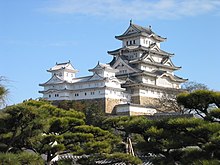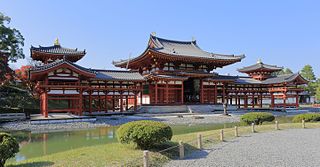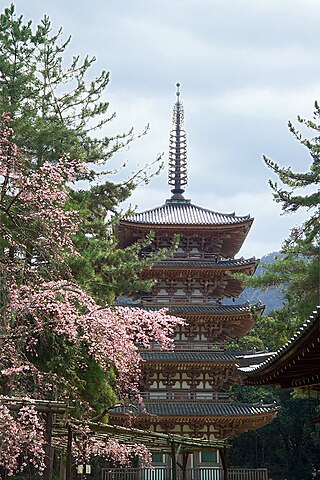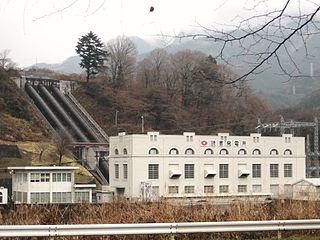
Lists of National Treasures of Japan cover different types of National Treasure of Japan. They include buildings and fine arts and crafts.

Lists of National Treasures of Japan cover different types of National Treasure of Japan. They include buildings and fine arts and crafts.

Byōdō-in is a Buddhist temple in the city of Uji in Kyoto Prefecture, Japan, built in the late Heian period. It is jointly a temple of the Jōdo-shū and Tendai-shū sects.

Tōdai-ji is a Buddhist temple complex that was once one of the powerful Seven Great Temples, located in the city of Nara, Japan. Though it was originally founded in the year 738 CE, Tōdai-ji was not opened until the year 752 CE. The temple has undergone several reconstructions since then, with the most significant reconstruction taking place in 1709. Its Great Buddha Hall houses the world's largest bronze statue of the Buddha Vairocana, known in Japanese as Daibutsu (大仏). The temple also serves as the Japanese headquarters of the Kegon school of Buddhism. The temple is a listed UNESCO World Heritage Site as one of the "Historic Monuments of Ancient Nara", together with seven other sites including temples, shrines and places in the city of Nara.

A National Treasure is the most precious of Japan's Tangible Cultural Properties, as determined and designated by the Agency for Cultural Affairs. A Tangible Cultural Property is considered to be of historic or artistic value, classified either as "buildings and structures" or as "fine arts and crafts." Each National Treasure must show outstanding workmanship, a high value for world cultural history, or exceptional value for scholarship.

The Nara National Museum is one of the pre-eminent national art museums in Japan.

The Kyoto National Museum is one of the major art museums in Japan. Located in Kyoto's Higashiyama ward, the museum focuses on pre-modern Japanese and Asian art.

Daigo-ji is a Shingon Buddhist temple in Fushimi-ku, Kyoto, Japan. Its main devotion (honzon) is Yakushi. Daigo, literally "ghee", is used figuratively to mean "crème de la crème" and is a metaphor of the most profound part of Buddhist thoughts.

The National Museum of Korea is the flagship museum of Korean history and art in South Korea and is the cultural organization that represents Korea. Since its establishment in 1945, the museum has been committed to various studies and research activities in the fields of archaeology, history, and art, continuously developing a variety of exhibitions and education programs.

Shitennō-ji is a Buddhist temple in Ōsaka, Japan. It is also known as Arahaka-ji, Nanba-ji, or Mitsu-ji. The temple is sometimes regarded as the first Buddhist and oldest officially-administered temple in Japan, although the temple complex and buildings have been rebuilt over the centuries, with the last reconstruction taking place in 1963. It is the head temple of the Wa Sect of Buddhism.

The Kunōzan Tōshō-gū (久能山東照宮) is a Shintō shrine in Suruga-ku in the city of Shizuoka in Shizuoka Prefecture, Japan. It is the original burial place of the first shōgun of the Tokugawa shogunate, Tokugawa Ieyasu, and is thus the oldest of the Tōshō-gū shrines in the country. The main festival of the shrine is held annually on April 17, although its spring festival on February 17–18 is a larger event.

Hōryū-ji is a Buddhist temple that was once one of the powerful Seven Great Temples, in Ikaruga, Nara Prefecture, Japan. Its full name is Hōryū Gakumonji (法隆学問寺), or Learning Temple of the Flourishing Law, the complex serving as both a seminary and monastery.

A Cultural Property is administered by the Japanese government's Agency for Cultural Affairs, and includes tangible properties ; intangible properties ; folk properties both tangible and intangible; monuments historic, scenic and natural; cultural landscapes; and groups of traditional buildings. Buried properties and conservation techniques are also protected. Together these cultural properties are to be preserved and utilized as the heritage of the Japanese people.

A Tangible Cultural Property as defined by the Japanese government's Law for the Protection of Cultural Properties is a part of the Cultural Properties of high historical or artistic value such as structures, paintings, sculptures, handicrafts, calligraphic works, ancient books, historic documents, archeological artifacts and other such items created in Japan. All objects which are not structures are called "works of fine arts and crafts.
The Tosa Yamauchi Family Treasury and Archives in Takajō-machi, Kōchi, Kōchi Prefecture, Japan, now permanently closed, formerly housed historical materials related to the Yamauchi clan, rulers of the Tosa Domain. Going back to an agreement between the Yamauchi family and Kōchi Prefecture from December 9, 1994, this foundation was formally established as a collaboration between Kōchi city and Kōchi Prefecture on April 26, 1995, with the aim of preserving and exhibiting the family's ancestral heritage of historical records, arts and crafts items. On May 1 of the same year the museum hall was opened.
The Maeda Ikutokukai (前田育徳会) foundation is a public interest corporation (公益法人) established on February 26, 1926 for the management and preservation of the cultural heritage of the Maeda clan, rulers of the Kaga Domain. It is located in Komaba, Meguro, Tokyo. The collection is centered on written materials including ancient documents or Japanese and Chinese books but also contains crafts items such as swords, armour or household items. The writings held by the foundation are known as Sonkeikaku library which is also used as an alias for Maeda Ikutokukai. This collection of old books, ancient records and documents is open to researchers on request only. The library's name is derived from the personal book collection of the 5th daimyō of Kanazawa Domain, Maeda Tsunanori, known as Sonkeikaku zōsho (尊経閣蔵書), which is distinct from the ancestral collection.

Kōyasan Reihōkan is an art museum on Kōya-san, Wakayama Prefecture, Japan, preserving and displaying Buddhist art owned by temples on Kōya-san. The collection is centered around articles from the Heian and Kamakura periods and includes paintings, calligraphy, sutras, sculpture and Buddhist ritual objects. Among these are a set of the complete Buddhist canon (issaikyō), writings of Kūkai and Minamoto no Yoritomo, founder of the Kamakura Shogunate, mandalas and portraits of priests. The most valuable objects have been designated as National Treasure or Important Cultural Property.

Kongō-ji (金剛寺) is a Buddhist temple in Kawachinagano, Osaka, Japan. It is the head temple of the Shingon Omuro sect. and also known under its mountain-name as Amanosan Kongō-ji. It is the 7th temple on the Shin Saigoku 33 Kannon Pilgrimage (新西国三十三箇所) and is notable for the large number of designated cultural properties. The precincts of the temple were designated a National Historic Site of Japan in 1934 with the area under protection expanded in 2011.